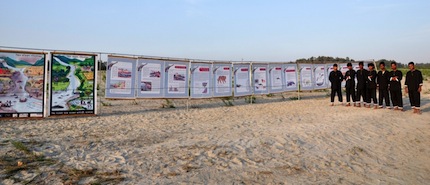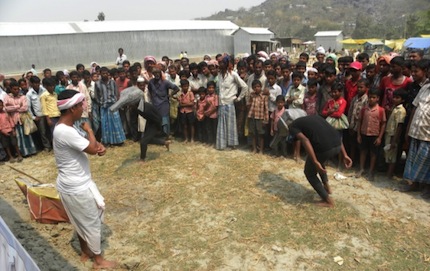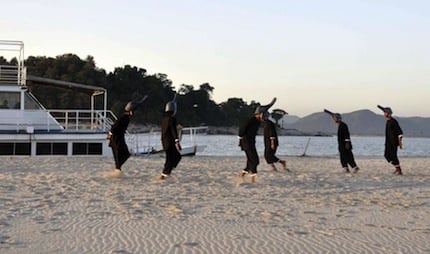A school of dolphins is singing and dancing by the riverside when screams break out as they come under attack from a group of fishermen. The mood turns dark and ugly. The dolphins are killed and their carcasses sold for oil, leading to protests from concerned citizens.
The scene from a mime show plays out in a village in India’s northeast state of Assam. It is drama but one which mirrors the bloody reality of the Ganga river dolphin, being hunted out of existence from the Brahmaputra that flows through the state. The target audience is the riverside fishing communities. The message seems to have hit home.
Mime artist Moinul Haque devised the show in 2013 to focus on the threat to the river dolphins in the Brahmaputra river system, one of the longest rivers in the world: “It was a novel experience for me” he says. “I tried to make it interesting by introducing a ‘dolphin dance’ in a Bollywood number at the beginning of the play. This managed to attract the fishermen in the area.”

Haque also trained a team of volunteer actors and educators for a unique Dolphin Yatra (Journey) along the Brahmaputra, Subansiri and Kulsi rivers aimed at increasing awareness of the issue through plays, posters, booklets and a feedback questionnaire.
“Since the majority of Gangetic dolphins live beyond protected area boundaries, effective conservation of this species in the Brahmaputra river system is entirely dependent on the local communities living in and around dolphin habitats. There is acute need for a well-defined mass community awareness and education campaign to be conducted through relevant riverside villages, especially those of fishermen in Assam,” says Abdul Wakid, one of the masterminds of the innovative campaign conducted in 2013 and head of the Gangetic Dolphin Research and Conservation Programme of the NGO Aaranyak.
“Dolphins are killed for meat and oil. Most of the riverine villagers in remote areas believe that dolphin oil has medicinal value and they use it to treat different rheumatic diseases,” he adds.
The Ganga river dolphin is listed as endangered by the International Union for Conservation of Nature (IUCN) and are found in the Ganga-Brahmaputra river systems in India and Bangladesh.
In comparison to the Ganga river system, little research on dolphins has been undertaken in the Brahmaputra river system of Assam in India. Elders in Assam recall that the Ganga dolphin used to be a common sight in the Brahmaputra.
But their numbers have dwindled sharply, estimated to have declined by at least 50% over the last 50 years.
According to Wakid, the species has been eradicated fom most of the major tributaries of the Brahmaputra and are now restricted to just pockets.
IUCN estimate that of a total population of about 2,000 worldwide, only about 300 dolphins are left in the Brahmaputra system. This is projected to decline even further. “Dolphins have been extirpated from the upper reaches of many rivers, the population has been fragmented by irrigation barrages and dry season habitat is further reduced by diversion of water. In comparison to the Ganga, the Brahmaputra River is less degraded and is therefore of great importance for persistence of the subspecies,” an IUCN report said.
The Dolphin Foundation estimates that only a few hundred are left in the Ganga as well as the Brahmaputra.
Many Ganga dolphins die after getting entangled in fishing nets. Poaching, pollution and over-exploitation of fish are also major factors for the dolphin being listed as amongst the most endangered aquatic mammals.
Dam building poses a future threat. Proposed mega dams in the river basin will directly affect the dolphin population by changing the whole ecological system of the river, said a report by Aaranyak.

Large dams on various forerunners and tributaries of Brahmaputra within Arunachal Pradesh and Meghalaya could lead to Brahmaputra river dolphins facing extinction, says Wakid. He demands that the ministry of environment and forests should not grant environmental clearances to the projects.
Among the 168 dams of northeast India, those on the Lower Siang (on Siang river), Dibang (on Dibang river), Lower Demwe (on Lohit), Lower Subansiri (on Subansiri river) and Kulsi pose the most danger to the Brahmaputra dolphins.
The dams on these rivers will affect the species by changing the type and seasonal availability of prey, disturbing dolphin habitat and disrupting the natural flow regime of the river. This has already happened elsewhere.
There is strong scientific evidence that large dams have already led to survival problems in Bangladesh, for instance.
While experts debate the technicalities, Aaranyak activist Monoj Kumar Das, who lives in a village in Assam’s Kamrup district, speaks of the strong connection between the dolphins and the community of fishermen. He recalls how a fisherman Naren Das developed a close affinity with a dolphin chasing fish close to his nets. When it was accidentally killed, he performed the last rites as he would do for a human.
